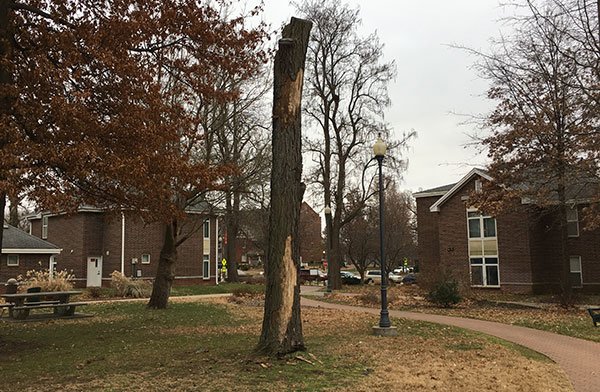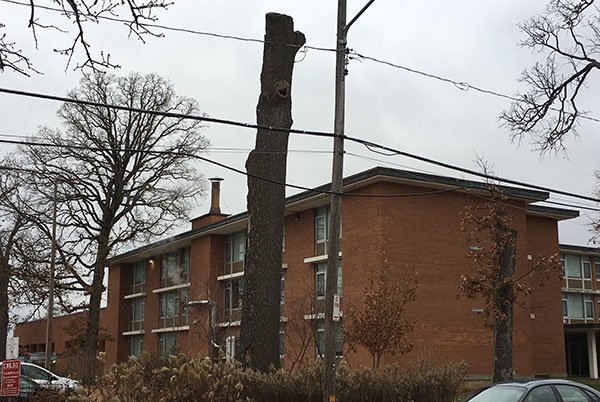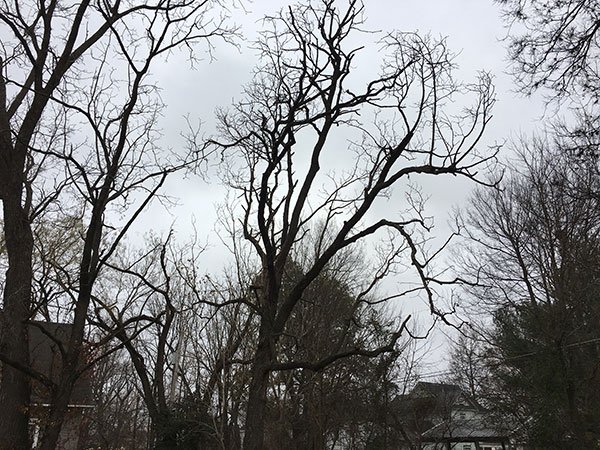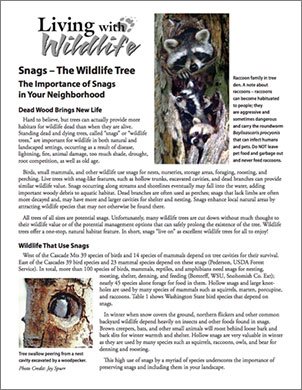Our Campus is Alive… With Dead Trees
Most grounds managers (including golf course superintendents) understand the important role that trees play in a landscape. Trees supply beautification, shade, pollution mitigation, etc. and on a golf course can add to the challenge of play. Show me a landscape devoid of trees and I will show you a landscape that is not even close to fulfilling its potential. The culture and maintenance of trees is a critical skill for a grounds crew and the amount of money spent on arboriculture emphasizes this importance. However, the life cycle of a tree continues long after it dies, and it can continue to play a significant role during decline, and even when dead in the landscape.

How We View Death in the Landscape
The modern landscape is devoid of dying or dead plants. As soon as any plant begins to decline, or is out and out dead, it is immediately removed from the landscape and replaced ASAP. Nothing dead can be tolerated in our gardens. This exclusion of dead tissue is actually counterproductive to maintaining a healthy ecosystem. By not allowing the life/death cycle to follow its course to fulfillment, we lop off a segment of this cycle even as the benefits of this process are starting to be released.
Decline and Death is Only the Beginning
All living organisms follow an arc as they go through their lives. Decline (senescence, if you will) is a stage that is marked by slower growth, isolated or widespread tissue death, and increased susceptibility to pests and disease. In trees, this decline corresponds with a marked increase of the tree to provide habitat. Nesting increases in newly appearing cavities. Insects begin to feed on wood and leaves that are no longer able to fend them-off (production of defensive compounds is slowed in stressed plants). In turn, birds feed on the insects that are hastening decline further. The truth is, there is far more wildlife and ecosystem benefit living in the cycle of dead trees than living ones.
The truth is, there is far more wildlife and ecosystem benefit living in the cycle of dead trees than living ones...
The importance of dead in a living landscape
Our landscapes are comprised of a multitude of organisms and cycles. Removing, or diminishing the diversity of organisms can damage the ecosystem and disrupt the continuation of cycles supporting our landscapes. The landscape carbon cycle requires dead plant material to return nutrients to the soil for turf and plants to use again. The organisms (micro and macro) that enhance the breakdown of organic material into carbon (and other essential nutrients) also require dead organic matter for survival. If we diminish the quantity of one, we diminish the quantity of the other. For this reason, our insistence on removing anything dead could be detrimental. Pests frequently invade trees that are stressed and declining. This attraction to these trees may draw pests away from other healthier trees, almost acting as trap plants. Regardless, dead plants are essential for any ecosystem.

Incorporating Habitat Trees on Campus
Our campus has about 20% crown cover based on iTree Canopy assessment. This means we have many trees to grow and manage. Our tree demographics reflect a tree age span range of 1-100+ years. This is a good thing. But it means that every year trees die. Big dead trees are obvious in the landscape. In Victorian Europe, dead trees were considered beautiful. Dead trees were frequently left in the landscape to accentuate, draw attention, and provide contrast. But I digress. Our grounds crew usually removes these trees promptly, but occasionally the circumstances around the tree allow us to suggest the creation of a habitat tree. However, creating habitat trees is not appropriate in all cases, but can be a vital part of a sustainable grounds management program.
...creating habitat trees is not appropriate in all cases, but can be a vital part of a sustainable grounds management program.
When and How Habitat Trees Make Sense
Habitat tree candidates (dead/dying), especially large trees, can be left untouched (if in wooded setting), or in our case, cut back to form posts or reduced trees. Since our entire campus is exposed to foot or vehicle traffic in some extent, any dead trees must first be mitigated for stability and safety. We do not want dead limbs dropping constantly. As a Certified Arborist, and in consultation with our tree Contractor, we determine if the location, species, stability, existing landscape context, etc. is right for a habitat tree. Next, we will cut the tree back to stable and durable structure that should remain intact for 5-10 years. Because the prime directive of dead trees is decomposition, habitat trees are regularly monitored to assess their safety and to screen for the time when complete removal is justified.

Dead/Dying Trees Are Alive
Dead and dying trees ARE actually full of life. Large dead/dying trees especially, provide shelter, food, and even beauty in the landscape. Habitat trees can be used to highlight the science of landscape management, embody ecologic cycles, and demonstrate a sustainable maintenance approach. Managing habitat trees is not about simply leaving a dead tree to save money or time. It is about guiding the landscape by letting nature run its full course, because it pays benefits to our landscapes and organizations.

Wildlife trees can take on many different shapes and sizes.



0 Comments
Recommended Comments
There are no comments to display.